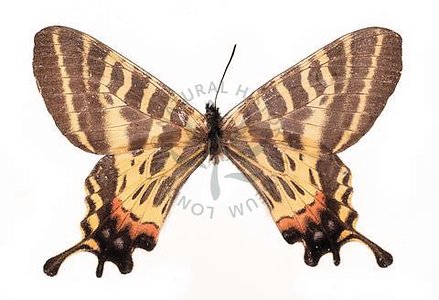Bhutanitis mansfieldi
Vazrick NazariIntroduction
The life history has been discussed in detail by Igarashi (2003).
According to Riley, who described the species in 1939, the type specimen was discovered by M. J. Mansfield among papered and unlabeled specimens from the collection of George Forrest, a British botanist who extensively collected in Yunnan, China. Riley therefore assumed that the type must have been collected in Yunnan. Morphological characters are discussed by Saigusa and Lee (1982) and Igarashi (2003), as well as Collins and Morris (1985). Genitalia have been illustrated by Chou (1992) and by Bai and Wang (1998).
Geographical Distribution
B. masfieldi is endemic to China (Yunnan, Sichuan) (Saigusa and Lee, 1982).
Geographical Variation
Two subspecies are recognized: B. mansfieldi mansfieldi (Riley, 1939) (Type locality: Yunnan, China), and B. mansfieldi pulchristata Saigusa and Lee, 1982 (Type locality: Sichuan, China) (Saigusa and Lee, 1982; Coote, 2000), although a recent molecular study has suggested that the name B. m. pulchristrata should be synonymized with nominal B. m. mansfieldi (Zhu et al., 2005).
Larval Food Plant
Only Aristolochia moupinensis has been recorded as a larval host plant in the wild (Lee, 1986; Chunsheng, 2001). In captivity, larvae also tolerate A. griffithii.
Nomenclature
Hiura (1980) erected a new genus, Yunnanopapilio Hiura, 1980, for B. mansfieldi, based on some wing pattern characters as well as venation; this name was later synonymized with Bhutanitis by Saigusa and Lee (1982). Chou (1992) gave species rank to B. m. pulchristrata, but this designation is generally not accepted.
References
Bai, J., Wang, X., 1998. Swallowtail butterflies in China. The Shu-Sheng Press, Taibei, China.
Chou, I., 1992. A Study on the rare butterflies of the genus Bhutanitis (Lepidoptera: Papilionidae) with descriptions of two new species. Entomotaxonomia, 14: 48-54.
Chunsheng, W., 2001. Zhongguo dong wu zhi. Kun chong gang. Di 25 juan, Lin chi mu feng die ke : feng die ya ke, ju feng die ya ke, juan die ya ke / Wu Chunsheng bian zhu ; Zhongguo ke xue yuan Zhongguo dong wu zhi bian ji wei yuan hui zhu bian. Fauna Sinica, Insecta Vol. 25: Lepidoptera Papilionidae; Papilioninae, Zerynthiinae, Parnassiinae. Beijing, Ke xue chu ban she, 367 pp.
Collins, N.M., Morris, M.G., 1985. Threatened Swallowtail Butterflies of the World: The IUCN Red data book. Gland, Switzerland. 401 pp.
Coote, L., 2000. CITES identification guide - Butterflies: Guide to the Identification of Butterfly Species Controlled Under the Convention on International Trade in Endangered Species of Wild Fauna and Flora. Ottawa: Canadian Wildlife Service.
Hiura, I., 1980. A phylogeny of the genera of Parnassiinae based on analysis of wing pattern, with description of a anew genus (Lepiopdtera: Papilionidae). Bulletin of the Osaka Museum of Natural History 33: 71-85.
Igarashi, S., 2003. Life history of Bhutanitis mansfieldi in comparison with those of related species. Butterflies (Publication of the Butterfly Society of Japan), 35:20-39.
Lee, C., 1986. First report on the life histories and phylogenetic position of two Chinese Papilionidae, Bhutanitis mansfieldi and B. thaidiana. Yadoriga 126: 17-21.
Riley, N.D., 1939. A new species of Armandia (Lep. Papilionidae). Entomologist 72: 207-208.
Saigusa, T., Lee, C., 1982. A rare papilionid butterfly Bhutanitis mansfieldi (Riley), its rediscovery, new subspecies and phylogenetic position. Tyō to Ga 33: 1-24.
Zhu, L.X., Wu, X.B., Yan, P., 2005. Molecular phylogenetic relationships among four species of Bhutanitis (Lepidoptera: Papilionidae) based on partial COI gene sequence. Acta Zootaxonomica Sinica 31: 25-30.
Title Illustrations

| Scientific Name | Bhutanitis mansfieldi |
|---|---|
| Location | China; collected by George Forrest, 1918 |
| Comments | Type specimen |
| Acknowledgements | The Natural History Museum Picture Library |
| Specimen Condition | Dead Specimen |
| Copyright | © The Natural History Museum, London |
About This Page
Vazrick Nazari

Canadian National Collection of Insects, Arachnids and Nematodes, Ottawa, Canada
Correspondence regarding this page should be directed to Vazrick Nazari at
Page copyright © 2006 Vazrick Nazari
 Page: Tree of Life
Bhutanitis mansfieldi .
Authored by
Vazrick Nazari.
The TEXT of this page is licensed under the
Creative Commons Attribution License - Version 3.0. Note that images and other media
featured on this page are each governed by their own license, and they may or may not be available
for reuse. Click on an image or a media link to access the media data window, which provides the
relevant licensing information. For the general terms and conditions of ToL material reuse and
redistribution, please see the Tree of Life Copyright
Policies.
Page: Tree of Life
Bhutanitis mansfieldi .
Authored by
Vazrick Nazari.
The TEXT of this page is licensed under the
Creative Commons Attribution License - Version 3.0. Note that images and other media
featured on this page are each governed by their own license, and they may or may not be available
for reuse. Click on an image or a media link to access the media data window, which provides the
relevant licensing information. For the general terms and conditions of ToL material reuse and
redistribution, please see the Tree of Life Copyright
Policies.
- First online 07 July 2006
- Content changed 07 July 2006
Citing this page:
Nazari, Vazrick. 2006. Bhutanitis mansfieldi . Version 07 July 2006 (under construction). http://tolweb.org/Bhutanitis_mansfieldi/65413/2006.07.07 in The Tree of Life Web Project, http://tolweb.org/








 Go to quick links
Go to quick search
Go to navigation for this section of the ToL site
Go to detailed links for the ToL site
Go to quick links
Go to quick search
Go to navigation for this section of the ToL site
Go to detailed links for the ToL site